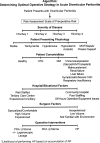Emergency management of diverticulitis
- PMID: 20676259
- PMCID: PMC2780262
- DOI: 10.1055/s-0029-1236160
Emergency management of diverticulitis
Abstract
The most common indications for emergency operative intervention in the treatment of sigmoid diverticulitis are peritonitis and failure of medical therapy. Primary resection and diversion (Hartmann's procedure) followed by delayed colostomy closure is the current standard of emergency surgical care. Guidelines for best operative strategy, however, remain controversial and continue to evolve based on recent comparative reviews of surgical outcomes. Primary resection and anastomosis with or without proximal diversion and laparoscopic lavage are alternatives to Hartmann's procedure that may provide an improved outcome in properly selected patients. Ongoing changes in the historical paradigm of the surgical approach to this disease mandate the need for large multicentered prospective randomized trials to determine the best surgical strategy under emergent conditions for the treatment of diverticulitis. The current literature is reviewed with suggestions for a management algorithm.
Keywords: Diverticular peritonitis; Hartmann's procedure; anastomosis; diverticulitis; laparoscopic lavage; peritonitis; primary resection.
Figures

Similar articles
-
Primary anastomosis after intraoperative colonic lavage vs. Hartmann's procedure in generalized peritonitis complicating diverticular disease of the colon.Int J Colorectal Dis. 2003 Nov;18(6):503-7. doi: 10.1007/s00384-003-0512-1. Epub 2003 Aug 9. Int J Colorectal Dis. 2003. PMID: 12910361 Clinical Trial.
-
[Choice of operative procedure in diverticular disease : Taking the latest treatment strategies into consideration].Chirurg. 2021 Aug;92(8):702-706. doi: 10.1007/s00104-021-01409-6. Epub 2021 Apr 26. Chirurg. 2021. PMID: 33903930 Review. German.
-
Resection and primary anastomosis with proximal diversion instead of Hartmann's: evolving the management of diverticulitis using NSQIP data.J Trauma Acute Care Surg. 2012 Apr;72(4):807-14; quiz 1124. doi: 10.1097/TA.0b013e31824ef90b. J Trauma Acute Care Surg. 2012. PMID: 22491590
-
Intraoperative colonic lavage with primary anastomosis vs. Hartmann's procedure for perforated diverticular disease of the colon: a consecutive study.Hepatogastroenterology. 2002 May-Jun;49(45):664-7. Hepatogastroenterology. 2002. PMID: 12063965
-
Management of perforated diverticulitis with generalized peritonitis. A multidisciplinary review and position paper.Tech Coloproctol. 2021 Feb;25(2):153-165. doi: 10.1007/s10151-020-02346-y. Epub 2020 Nov 5. Tech Coloproctol. 2021. PMID: 33155148 Free PMC article. Review.
Cited by
-
Laparoscopic Versus Open Emergent Sigmoid Resection for Perforated Diverticulitis.J Gastrointest Surg. 2020 May;24(5):1173-1182. doi: 10.1007/s11605-019-04490-9. Epub 2019 Dec 16. J Gastrointest Surg. 2020. PMID: 31845141
-
Is colonoscopy necessary after computed tomography diagnosis of acute diverticulitis?Intest Res. 2014 Jul;12(3):221-8. doi: 10.5217/ir.2014.12.3.221. Epub 2014 Jul 25. Intest Res. 2014. PMID: 25349596 Free PMC article.
-
Colovesical Fistula due to Sigmoid Diverticulitis.Case Rep Surg. 2023 Dec 4;2023:8835222. doi: 10.1155/2023/8835222. eCollection 2023. Case Rep Surg. 2023. PMID: 38090132 Free PMC article.
-
Factors Associated with Repeated Health Resource Utilization in Patients with Diverticulitis.J Gastrointest Surg. 2017 Jan;21(1):112-120. doi: 10.1007/s11605-016-3245-5. Epub 2016 Sep 9. J Gastrointest Surg. 2017. PMID: 27613732
-
Conservative treatment of acute cholecystitis: a systematic review and pooled analysis.Surg Endosc. 2017 Feb;31(2):504-515. doi: 10.1007/s00464-016-5011-x. Epub 2016 Jun 17. Surg Endosc. 2017. PMID: 27317033
References
-
- Comparato G, Di Mario F, NDSG Recurrent diverticulitis. J Clin Gastroenterol. 2008;42(10):1130–1134. - PubMed
-
- Munson K D, Hensien M A, Jacob L N, Robinson A M, Liston W A. Diverticulitis. A comprehensive follow-up. Dis Colon Rectum. 1996;39(3):318–322. - PubMed
-
- Wong W D, Wexner S D, Lowry A, et al. The American Society of Colon and Rectal Surgeons Practice parameters for the treatment of sigmoid diverticulitis—supporting documentation. The Standards Task Force. Dis Colon Rectum. 2000;43(3):290–297. - PubMed
-
- Etzioni D A, Mack T M, Beart R W, Jr, Kaiser A M. Diverticulitis in the United States: 1998-2005: changing patterns of disease and treatment. Ann Surg. 2009;249(2):210–217. - PubMed
-
- Abbas S. Resection and primary anastomosis in acute complicated diverticulitis, a systematic review of the literature. Int J Colorectal Dis. 2007;22(4):351–357. - PubMed

